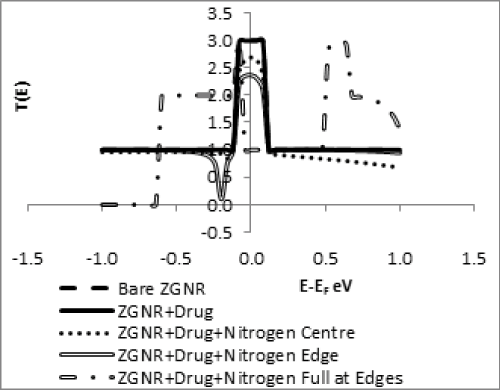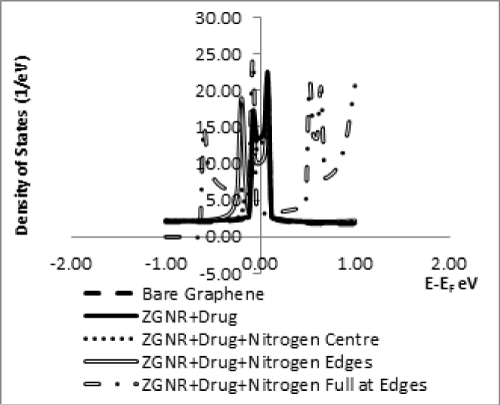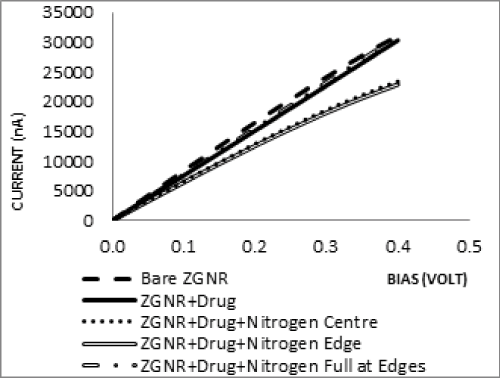
Research Article
Austin J Nanomed Nanotechnol. 2014;2(1): 1007.
Electron Transport of Zigzag Graphene Nanoribbon Based Biosensor-A Future Perspective towards Biosensor and Biomedical Applications
K.Janani, C. Preferencial Kala, R.M.Hariharan, S. Sivasathya, and D.John Thiruvadigal*
Department of Physics and Nanotechnology, SRM University, Kattankulathur, Chennai-603 203.
*Corresponding author: : D.John Thiruvadigal, Department of Physics and Nanotechnology
Received: January 02, 2014; Accepted: January 16, 2014; Published: January 23, 2014
Abstract
Graphene, the profound mother of carbon nanostructures has attracted tremendous attention towards biosensor and biomedical research through its enhanced property of sensitivity and specificity. In the present study, we explore the biological applications of zigzag graphene nanoribbon (ZGNR) as molecularscale biosensors by calculating the electronic properties of zigzag graphene nanoribbon (ZGNR) and paracetamol drug ensemble. Here the drug is adsorbed at the edge of ZGNR through physisorption. The non-covalent interaction between ZGNR and the drug is studied by calculating the transmission spectrum and density of states using non-equilibrium Green's function formalism (NEGF) and density functional theory(DFT).We have simulated different systems like bare ZGNR, hybrid system consisting of ZGNR and paracetamol, hybrid system with central doping of nitrogen, hybrid system with edge doping of nitrogen, hybrid system consisting of nitrogen replacing one complete edge layer carbon atoms and their corresponding I-V characteristics and transmission spectrum are reported. Our results show a significant suppression of transmission spectrum supported by the variation in density of states (DOS) thereby showing a distinct response to the molecule for sensing action. Further, bare ZGNR system is chosen as the reference. The decrease in the I-V characteristics of all the chemically modified systems clearly indicates tuning of band gap thus proving the sensing effect of ZGNR for biomedical applications.
Keywords: Zigzag graphene nanoribbon, Paracetamol drug, Non-Equilibrium Green's function, Density functional theory, Transmission spectrum, I-V characteristic.
Introduction
Graphene is a rapidly rising star on the horizon of materials science and condensed matter physics.1Graphene is made up of a single layer of carbon atoms packed into a two dimensional honeycomb lattice.[2-5] Since its discovery in 2004, graphene has been extensively studied in many different fields including nanoelectronics, composite materials, energy research, catalysis, and more recently biomedicine.[20] Utilizing the interesting optical, electrical, and chemical properties of graphene, various graphene-based biosensors have been fabricated to detect biomolecules with high sensitivities.[6]Graphene nanoribbons (GNRs) are quasi-one-dimensional structure, which are stripes of graphene. Their structures and their electronic properties have been intensively studied both experimentally and theoretically. The properties of GNR can be tuned by morphology control and chemical doping. While the chemical modification is expected for improved specificity, structural modification of graphene can further improve its sensitivity.[7]To begin with, the development of sensitive and rapid methods for determination of trace amounts of various ions and molecules in human biological samples, serum, plasma and urine were analyzed by fabricating different voltammetric and potentiometric sensors and tested effectively for their sensing efficiency.[22-44]The advent of nanomaterials created the ease to fabricate highly efficient biosensors using fullerene-C[60]-modified edge plane pyrolytic graphite electrode, modified glassy carbon electrode and single-wall carbon nanotubes modified pyrolytic graphite electrode for the detection of biological entity in pharmaceutical formulations and human biological fluids.[45-48]The non-covalent interaction of graphene with biomolecules have been reported for loading of doxorubicin drug in cancer therapy.[8]
Depending on the termination style, normally, GNR can be divided into two kinds: armchair graphene nanoribbon (AGNR) and zigzag graphene nanoribbon (ZGNR).[9]In particular, different quantization rules have been predicted for pure GNR's with zigzag (ZGNR's)[10]and armchair(AGNR's)[11,22] edge shaped. Edge states present in zigzag ribbons provide a single channel for electron conduction which is not the case for the armchair configuration.[2]
Paracetamol is a widely used analgesic (pain reliever) and antipyretic (fever reducer). In combination with opioid analgesics, paracetamol is used in palliative care in advanced cancer patients. [13,18] Paracetamol is not considered carcinogenic at therapeutic doses.[19]
The robust nature of ZGNR makes it an interesting material to be utilized for biosensing and biomedical applications. The purpose of the study is to understand the interaction between a drug (paracetamol) and zigzag graphene nanoribbon in terms of variation in the electrical characteristics which will be helpful while fabricating the biosensor devices.
Modeling and Methods
In our study, we have simulated different systems like bare ZGNR, hybrid system consisting of ZGNR and paracetamol adsorbed on one of the edges of ZGNR through p-p interaction (physisorption), hybrid system with central doping of nitrogen, hybrid system with edge doping of nitrogen, hybrid system with nitrogen replacing one complete edge layer carbon atoms (Fig1, a-e) and their corresponding I-V characteristics and transmission spectrum are reported.
Figure 1 (a): Quasi 1D structure of bare ZGNR (6,0) two probe device with 10 unit cells
Figure 1 (b): Geometrical representation of two probe hybrid system consisting of an ensemble of ZGNR and Paracetamol (C8H9O2)
Figure 1 (c): Hybrid system with central doping of nitrogen
Figure 1 (d): Hybrid system with edge doping of nitrogen
Figure 1 (e) Hybrid system with nitrogen replacing one complete edge layer carbon atoms
Our calculations were performed based on non-equilibrium Green's function formalism (NEGF) and density functional theory (DFT) using ATOMISTIX TOOL KIT-Virtual Nano Lab (ATKVNL).[ 14,21]The modeled device consists of 10 unit cells of ZGNR (6, 0), passivated by hydrogen at the edges in order to remove theeffect of dangling bonds. The C-C and C-H bond lengths are set to be 1.42 and 1.1 Å. As an exchange correlation function, the local density approximation (LDA) was used to perform the total energy calculations. For convergence; the Brillouin zone is sampled by1x1x300 k-points in the direction of x, y, z where z is the transport direction. The force tolerance was set to be 0.05 eV/Å. Our system had a complex structure of ZGNR and paracetamol drug consisting of 99 atoms, hence single zeta polarized basis set was used to save the computational time. The lattice parameters were set to be ≥ 10 Å in order to avoid the interaction between simulation cell and the device. The following program parameters used in the present study are:
The iteration mixing parameter: Pulay Mixer, Diagonal mixing parameter =0.1
Energy contour integral parameters: Circle points =30, Integral lower bound=3 Ry, Real axis infinitesimal=0.01eV and Real axis point density=0.02 eV.
Iteration control parameters: Tolerance=10-5
Device algorithm parameters: Electrode constraint = off and Initial density type =Equivalent Bulk
Basic settings: Temperature=300 K, Density mesh cut-off=150 Ry.
The NEGF-DFT description of electron transport is based on the Kohn-Sham equations which introduce an equation of motion for each electron through the one-electron Schrödinger equation given by,
where ψα(r) is the wave function of the electron in orbital α and Veff(r) is the DFT mean field potential from the other electrons[15].
Using NEGF theory, the transmission coefficients can be obtained as,
Here the subscripts C, L, and R are used to denote central scattering, left electrodes, and right electrodes, respectively. GC and γL(R) denote the corresponding Greens functions and imaginary parts of the self-energies, respectively[17].
The current passing through the device is calculated by the Landauer formula[16].
Here μL and μR are the chemical potential of the left and right electrodes, kB is the Boltzmann constant, Ttemp is the temperature, is the Fermi-Dirac distribution function, and T (E) is the transmission function.
Results
The transmission spectrum of all the five systems have been studied at zero bias as shown in Figure 2. Significant reduction in transmission coefficient was observed for all the five systems. The reduced probability of electron transmission is due to the effective blocking of edge states of ZGNR created by chemical modification and by using substitutional impurity like nitrogen. By analyzing the transmission spectrum of the five systems we observe that, the effective reduction in transmission at the Fermi level (EF=0) was more pronounced for edge doping than central doping of nitrogen leading to the strong physisorption of the drug with ZGNR edges. Thus we observe that the doped system was effective in reducing the conduction compared to the undoped system.
Figure 2: Transmission spectrum at zero bias of ZGNR with drug and dopant
The density of states (DOS) for the five systems is shown in Figure 3. We observed large DOS for all the systems near the Fermi level at zero bias; this is due to the intrinsic property of ZGNR.
Figure 3 Density of states at zero bias of ZGNR with drug and dopant.
The presence of peaks at the (Highest occupied molecular orbital) HUMO and LUMO levels (Lowest unoccupied molecular orbital) proves the excellent conduction property arising due to effective tunneling of electrons of ZGNR at zero bias. The suppression of DOS at Fermi level (EF=0) is more pronounced with the edge doping of nitrogen compared to the hybrid system. Edge doping along with hemical modification (using the drug) is effective in opening of band gap of zigzag graphene nanoribbon thereby showing the sensing effect of ZGNR.
In addition, the total energy calculations (ETOTAL) were performed for all the five systems at zero bias and it is reported in table 1. The variation in total energy with reference to bare ZGNR was more pronounced for the doped system compared to all the other device configurations.
SENSOR
ETOTAL
Bare ZGNR
-5863.74143 eV
ZGNR and Paracetomol
-8879.33093 eV
Hybrid system with nitrogen doping at the centre
-8990.94447 eV
Hybrid system with nitrogen doping at the edges
-8992.63498 eV
Hybrid system with nitrogen decoration at one of the edges
-9671.75750 eV
Table 1: ETOTAL (eV) at zero gate bias of ZGNR with drug and dopant.
The I-V characteristics as shown in Figure 4 performed with an applied bias range of 0.0 to 0.4 V show a linear response along with decrease in the electrical characteristics (current) for the five different systems. We find that the reduction in current is more pronounced for the hybrid system having edge doping of nitrogen with respect to the bare ZGNR as reference system. Thus, doping with substitutional impurity plays a major role in controlling the transmission and I-V thereby creating a significant sensing action.
Figure 4: I-V characteristics of ZGNR with drug and dopant.
Conclusion
In summary we have designed different biosensing systems by chemical modification of ZGNR with a drug molecule. Parallely substitutional impurity (nitrogen) is added to the hybrid system and the current-voltage characteristics were analyzed. We see a significant variation in the transmission spectrum and I-V characteristics which shows effective biosensing of ZGNR devices. Thus the study provides a valuable tool for understanding the interaction of drug and ZGNR, which could be used for the development biosensor applications to check for the dosage levels when used in palliative care for the patients suffering from Cancer.
Acknowledgements
The authors gratefully acknowledge the financial support for this project from DST-FIST, Government of India (Ref.No.SR/FST/PSI- 010/2010).
References
- GeimA.K. , K.S. Novoselov. The rise of graphene. Nature Materials.2007; 6:183 - 191.
- R. Chowdhury, S. Adhikari,P. Rees, and S. P. Wilks.Graphene-based biosensor using transportproperties. Physical Review B.2010; 00, 005400:1-8.
- Wallace, P. R. The band theory of graphite. Phys. Rev. 1947; 71: 622-634.
- McClure, J.W. Diamagnetism of graphite. Phys. Rev.1956; 104:666-671.
- Slonczewski, J.C., Weiss, P.R. Band structure of graphite. Phys. Rev.1958;109: 272-279.
- Bo Tian, Chao Wang, Shuai Zhang, LiangzhuFeng, and Zhuang Liu. PhotothermallyEnhancedPhotodynamic Therapy Delivered by Nano-Graphene Oxide. ACS Nano.2011; 5 :7000-7009.
- Phong Nguyen and Vikas Berry. Graphene Interfaced with Biological Cells: Opportunities and Challenges. J. Phys. Chem. Lett.2012; 3: 1024-1029.
- Xiaoming Sun, Zhuang Liu, Kevin Welsher, Joshua Tucker Robinson, Andrew Goodwin, SasaZaric and Hongjie Dai. Nano-Graphene Oxide for Cellular Imaging and Drug Delivery. Nano Res.2008; 1: 203-212.
- ErjunKan, Zhenyu Li and Jinlong Yang. GrapheneNanoribbons: Geometric, Electronic, and Magnetic Properties. cdn.intechopen.com/pdfs/14444/InTech-Graphene_nanoribbons_geometric_electronicand_magnetic_properties.pdf
- J. Park, H. Yang, K. S. Park, and E.-K. Lee.Effects of nonmagnetic impurities on the spin transport property of a graphenenanoribbon device.J. Chem. Phys.2009; 130.
- H. B. Heersche, P. Jarillo-Herrero, J. B. Oostinga, L. M. K.Vandersypen, and A. F. Morpurgo. Bipolar supercurrent in grapheme. Nature (London).2007;446:56.
- S. K. Maiti. Electron transport through honeycomb lattice ribbons with armchair edges.Solid State Commun.2009; 149:973.
- F. Franceschi, P. Iacomini, D. Marsiliani, C. Cordischi, E. Forte,S. Antonini, A. Alesi, D. Giacobelli, G. Zuccalà. Safety and efficacy of the combination Acetaminophen-Codeine in the treatment of pain of different origin. European Review for Medical and Pharmacological Sciences.2013; 17: 2129-2135.
- Atomistix Tool Kit Version 12.8.2. www.quantumwise.com
- K Stokbro. First-principles modeling of electron transport. Journal of Physics: Condensed Matter. 2008; 20, 064216:1-7.
- M.Büttiker, Y.Imry, R.Landauer and S.Pi?has. Generalized many- channel conductance formula with application to small rings. Physical Review B.1985;31,10:6207-6215.
- R. Chowdhury, F.Scarpa and S. Adhikari. Molecular scale biosensing using armchair graphene. Journal of Applied Physics.2012;112,014905:1-6.
- Scottish Intercollegiate Guidelines Network. Guideline 106:Control of pain in adults with cancer. Scotland National Health Service(NHS):2008.
- K. Bergman,L. Müller,S.WebergTeigen. The genotoxicity and carcinogenicity of paracetamol: a regulatory (re) view. Mutat Res.1996;349:263-288.
- Shouvik Banerjee, Jiwook Shim, Jose Rivera,Xiaozhong Jin, David Estrada, Vita Solovyeva, Xueqiu You, James Pak, Eric Pop, NarayanaAluru and Rashid Bashir. Electrochemistry at the Edge of a Single graphene Layer in a Nanopore.ACS Nano.2013;7:834-843.
- J.M. Soler, E. Artacho, J.D. Gale, A. Garci'a, J. Junquera, P. Ordejo' n and D. Sa' nchez-Portal. The SIESTA method for ab initio order-N materials simulation. J. Phys. Condens. Matter.2002; 14: 2745.
- V.K. Gupta, A.K. Jain, P. Kumar, S. Agarwal, G. and Maheshwari. Chromium(III)-selective sensor based on tri-o-thymotide in PVC matrix. Sensors and Actuators, B: Chemical.2006; 113 : 182-186.
- V.K. Gupta, A.K. Jain, Maheshwari, Heinrich Lang and Z. Ishtaiwi. Copper(II)-selective potentiometric sensors based on porphyrins in PVC matrix. Sensors and Actuators, B: Chemical.2006; 117: 99-106.
- V.K. Gupta, A.K. Jain and Pankaj Kumar. PVC-based membranes of N, N'-dibenzyl-1,4,10,13-tetraoxa-7,16 diazacyclooctadecane as Pb(II)-selective sensor. Sensors and Actuators, B: Chemical.2006; 120: 259-265.
- Vinod K. Gupta, Sudeshna Chandra and Heinrich Lang. A highly selective mercury electrode based on a diamine donor ligand. Talanta.2005; 66: 575-580.
- Vinod K Gupta, Rajendra Prasad and Azad Kumar. Preparation of ethambutol-copper(II) complex and fabrication of PVC based membrane potentiometric sensor for copper. Talanta.2003: 60; 149-160.
- Vinod K Gupta, Sudeshna Chandra and RajniMangla. Dicyclohexano-18-crown-6 as active material in PVC matrix membrane for the fabrication of cadmium selective potentiometric sensor. ElectrochimicaActa.2002: 47 ; 1579-1586.
- Rajendra N. GoyalVinod K. Gupta and SanghamitraChatterjee. Electrochemical oxidation of 2',3'-dideoxyadenosine at pyrolytic graphite electrode. ElectrochimicaActa.2008: 53; 5354-5360.
- Rajendra N. GoyalVinod K. Gupta and SanghamitraChatterjee. A sensitive voltammetric sensor for determination of synthetic corticosteroid triamcinolone, abused for doping. Biosensors and Bioelectronics.2009: 24; 3562-3568.
- Rajeev Jain, Vinod K. Gupta, N. Jadonand K. Radhapyari. Voltammetric determination of cefixime in pharmaceuticals and biological fluids. Analytical Biochemistry.2010:407; 79-88.
- Vinod K. Gupta, Rajeev Jain, KeishamRadhapyari, NimishaJadon and ShilpiAgarwal. Voltammetric techniques for the assay of pharmaceuticals-A review. Analytical Biochemistry.2011: 408; 179-196.
- Vinod K. Gupta, Rajendra N. Goyal and Ram A. Sharma. Novel PVC Membrane Based Alizarin Sensor and its application; Determination of Vanadium, Zirconium and MolybdenumInt. J. Electrochem. Sci. 2009: 4 ; 156-172.
- Imran Ali, Vinod K. Gupta, Tabrez A. Khan and MohdAsim. Removal of Arsenate from Aqueous Solution by Electro-Coagulation Method Using Al-Fe Electrodes. Int. J. Electrochem. Sci. 2012: 7; 1898-1907.
- Vinod Kumar Gupta,Rajeev Jain, Sandeep Sharma, ShilpiAgarwal and AshishDwivedi. Quantitative Determination of Alendronate in Human Urine. Int J. Electrochem. Sci.2012: 7;569 - 587.
- V.K. Gupta, Imran Ali and ShilpiAgarwal. Enantiomeric Analysis of Citalopram in Human Plasma by SPE and Chiral HPLC Method. Int J. Electrochem. Sci.2011: 6;5639-5648.
- Vinod K. Gupta,ShilpiAgarwal and BarkhaSinghal. Potentiometric Assay of Antipsychotic Drug (Ziprasidone Hydrochloride) in Pharmaceuticals, Serum and Urine. Int. J. Electrochem.Sci. 2011:6; 3036 - 3056.
- Vinod Kumar Gupta,BhavanaSethi,NirajUpadhyay, Sunita Kumar, Rakesh Singh and LokPratap Singh. Iron (III) Selective Electrode Based on S-Methyl N-(Methylcarbamoyloxy) Thioacetimidate as a Sensing Material. Int. J. Electrochem. Sci.2011: 6; 650 - 663.
- Vinod K. Gupta, Rajeev Jain, Milan M. Antonijevic, HadiKhani , M. N. Siddiqui, AshishDwivedi, Ritesh Mishra and ShilpiAgarwal. Assay of Nimodipine - an Anti Hypertensive drug, in Bulk Form and Pharmaceutical Formulations by Cathodic Adsorptive Stripping Voltammetry Int. J. Electrochem. Sci.2011: 6; 37 - 51.
- Vinod K. Gupta, Rajeev Jain and Manoj K. Pal.Mn2+ Selective Electrode Based on 3-(6-Aminopyridin-2-Ylimino)-1, 3-Diphenylpropylidene) Pyridine-2, 6-Diamine.Int. J. Electrochem. Sci.2010: 5; 1164-1178.
- Vinod K Gupta, Ajay K Jain, Lok P Singh and UpendraKhurana. Porphyrins as carrier in PVC based membrane potentiometric sensors for nickel(II).AnalyticaChimicaActa.1997:355; 33-41.
- Vinod K Gupta, R Prasad, P Kumar and RMangla. New nickel(II) selective potentiometric sensor based on 5,7,12,14-tetramethyldibenzotetraazaannulene in a poly(vinylchloride) matrix.AnalyticaChimicaActa.2000: 420;19-27.
- Vinod Kumar Gupta,Ashok Kumar Singh, SameenaMehtab and Barkha Gupta. A cobalt(II)-selective PVC membrane based on a Schiff base complex of N,N'-bis(salicylidene)-3,4-diaminotoluene.AnalyticaChimicaActa. 2006: 566; 5-10.
- Rajendra N. Goyal, Vinod K. Gupta and Neeta Bachheti.Fullerene-C60 modified electrode as a sensitive voltammetric sensor for detection of nandrolone-An anabolic steroid used in doping. AnalyticaChimica Acta.2007:597; 82-89.
- V.K. Gupta,A.K. Singh, M. Al Khayat and Barkha Gupta. Neutral carriers based polymeric membrane electrodes for selective determination of mercury (II).AnalyticaChimica Acta.2007: 590; 81-90.
- Vinod K. Gupta, Maysoon Al Khayat,Ashok K. Singh and Manoj K. Pal. Nano level detection of Cd(II) using poly(vinyl chloride) based membranes of Schiff bases AnalyticaChimicaActa. 2009:634 ;36-43.
- Rajendra N. GoyalVinod K. Gupta and SanghamitraChatterjee. Fullerene-C60-modified edge plane pyrolytic graphite electrode for the determination of dexamethasone in pharmaceutical formulations and human biological fluids. Biosensors and Bioelectronics.2009:24; 1649-1654.
- Mu. Naushad, V.K. Gupta, S.M. Wabaidurand Z. A. Alothman. Simultaneous Determination of Benserazide and Levodopa in Pharmaceutical Tablet, Human Serum and Urine Sample by Differential Pulse Voltammetry Using Modified Glassy Carbon Electrode. Int. J. Electrochem. Sci.2013: 8 ;297 - 311.
- Rajendra N. GoyalVinod K. Gupta and SanghamitraChatterjee. Simultaneous determination of adenosine and inosine using single-wall carbon nanotubes modified pyrolytic graphite electrode. Talanta.2008: 76; 662-668.
.gif)
.gif)
.gif)
.gif)
.gif)


